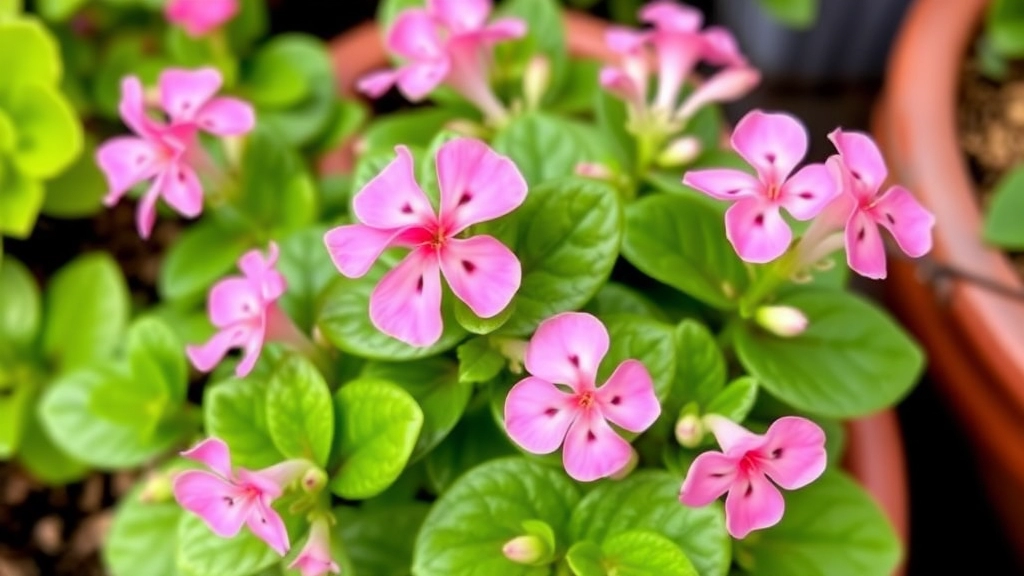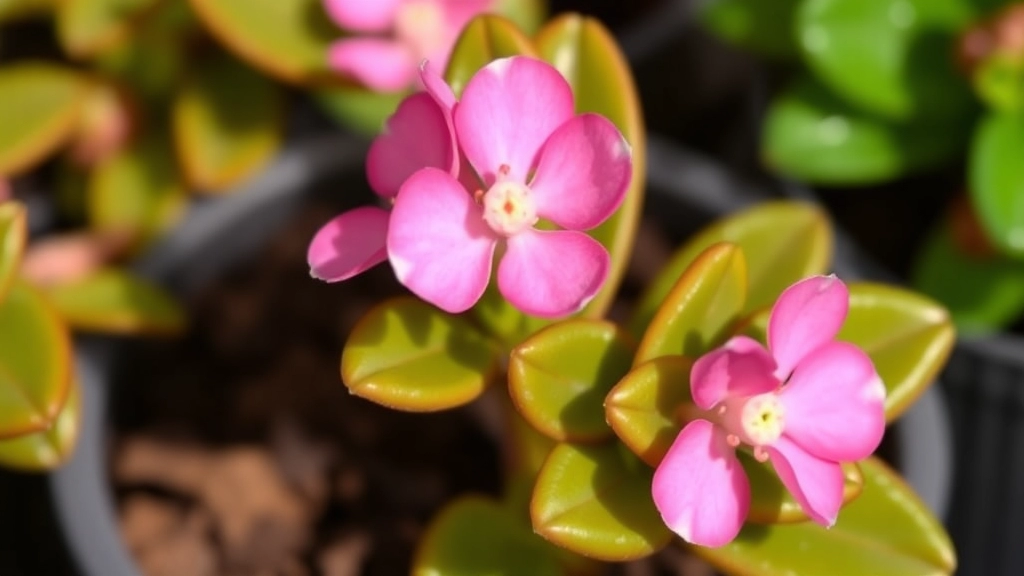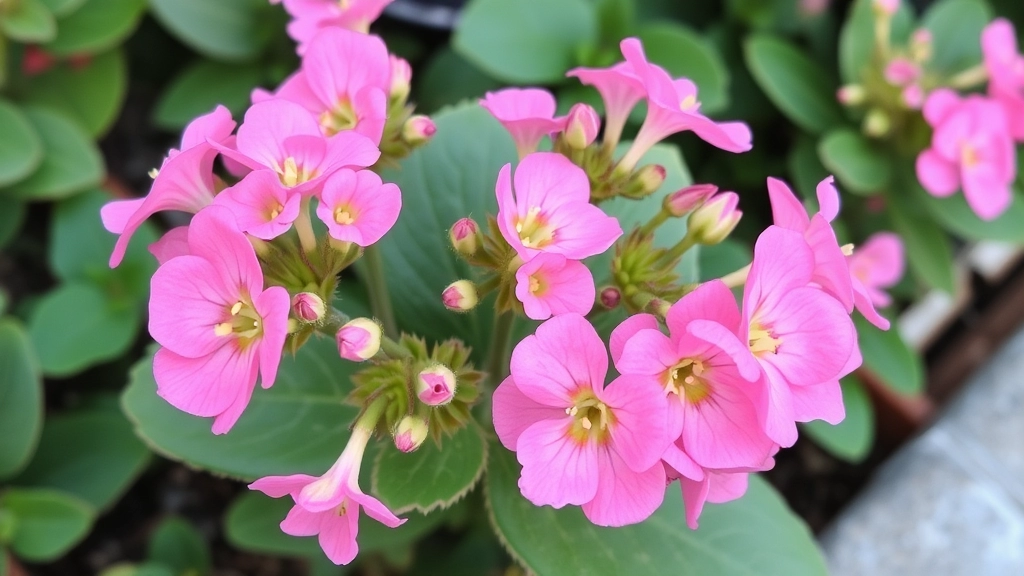The Pink Butterflies Kalanchoe
The Pink Butterflies Kalanchoe, often known as the Mother of Thousands, is a fascinating succulent that stands out due to its unique pink bulbils. These tiny plantlets resemble delicate butterflies, making it a favourite among succulent enthusiasts. If you’re looking to add this eye-catching plant to your collection, understanding its specific care requirements is crucial for its thriving growth.
Optimal Growing Conditions
Optimal growing conditions for the Pink Butterflies Kalanchoe include:
- Plenty of sunlight
- Well-draining soil
- Minimal watering
This plant thrives in bright, indirect light and prefers to dry out between watering sessions.
Propagation and Care
Propagating this succulent is straightforward; simply plant the bulbils in soil, and they will root and grow into new plants. Keeping pests at bay is essential, so regular checks and appropriate treatments will ensure your Kalanchoe remains healthy and vibrant.
Kalanchoe ‘Pink Butterflies’ is renowned for its striking appearance and easy-care nature. Its standout feature is the clusters of delicate, pink flowers that bloom in abundance, creating a stunning contrast against the lush foliage. This plant typically grows upright, reaching a height of about 30cm, making it perfect for tabletops or windowsills.
Kalanchoe ‘Pink Butterflies’ is not just a pretty face; it’s also remarkably resilient. This succulent thrives in dry conditions, requiring minimal watering. It’s an excellent choice for both novice and experienced gardeners, as it demands little attention once established. For more detailed care tips, you can refer to the [Pink Kalanchoe Succulent Care Tips for Healthy Growth](https://planthq.org/pink-kalanchoe-succulent-care-tips-for-healthy-growth/) guide.
If you’re interested in exploring other Kalanchoe varieties, the [Types of Kalanchoe Tomentosa Varieties and Care Tips](https://planthq.org/types-of-kalanchoe-tomentosa-varieties-and-care-tips/) can provide you with comprehensive information on different types and their specific care requirements.
Ideal Growing Conditions for Kalanchoe ‘Pink Butterflies’

So, you’ve got your heart set on Kalanchoe ‘Pink Butterflies’, but what’s the best way to keep this beauty thriving?
First things first, let’s talk about light.
Kalanchoe ‘Pink Butterflies’ loves bright, indirect sunlight.
Think of a spot where it can soak up those rays without getting scorched.
- Direct Sunlight: Too much can burn the leaves.
- Low Light: This can lead to leggy growth.
- Ideal Spot: A south or west-facing window is often a winner.
Next up, temperature.
These plants prefer warmth, ideally between 20°C to 25°C during the day and a bit cooler at night.
If your home is chilly, don’t fret; just keep it away from drafts and cold windows.
Humidity? Not an issue.
Kalanchoe ‘Pink Butterflies’ is pretty adaptable and does well in average indoor humidity levels.
Just remember to avoid overly damp areas, as that can lead to problems.
Now, let’s talk about soil.
A well-draining potting mix is key.
You can either buy a cactus mix or create your own by mixing regular potting soil with sand or perlite.
This ensures that excess water drains away, keeping your plant happy.
Finally, don’t forget about pot size.
Choose a pot that’s just a little bigger than the root ball.
This helps prevent overwatering, which is a common pitfall for new plant parents.
Watering and Fertilization for Kalanchoe ‘Pink Butterflies’
As we delve deeper into the care of Kalanchoe ‘Pink Butterflies’, one of the most pressing concerns for many plant enthusiasts is understanding the right watering and fertilization techniques.
Watering Guidelines
Kalanchoe ‘Pink Butterflies’ thrives in well-draining soil, making proper watering essential. Overwatering can lead to root rot, while underwatering can stunt growth. Here are some key points to consider:
- Frequency: Water when the top inch of soil feels dry. This usually translates to every 2-3 weeks, depending on the season.
- Method: Water deeply but infrequently. Ensure excess water drains out from the pot’s bottom.
- Signs of Overwatering: Yellowing leaves or a mushy stem indicate too much water.
- Signs of Underwatering: Wrinkled leaves or a drooping appearance suggest the plant needs hydration.
Fertilization Tips
Fertilizing Kalanchoe ‘Pink Butterflies’ is vital for promoting vibrant blooms and healthy growth. However, it’s important to strike a balance to avoid nutrient burn. Consider these tips:
- Type of Fertilizer: Use a balanced, water-soluble fertiliser, ideally one formulated for succulents.
- Frequency: Fertilize every 4-6 weeks during the growing season (spring and summer). Reduce or stop during fall and winter.
- Dilution: Always dilute the fertiliser to half strength to prevent over-fertilization.
For more detailed care tips on similar plants, check out our complete guide to caring for Kalanchoe Tomentosa and our optimal care guide for Kalanchoe Blossfeldiana.
Propagation Methods for Kalanchoe ‘Pink Butterflies’

As we delve into propagation methods, it’s essential to remember that Kalanchoe ‘Pink Butterflies’ can be easily multiplied, making it a delightful addition to any garden or indoor space.
Common Propagation Techniques
- Leaf Cuttings
– Select healthy, mature leaves from the plant.
– Allow the cut end to callous over for a few hours or overnight.
– Place the leaf in a well-draining soil mix, ensuring it’s upright.
– Water lightly and keep in a warm, bright location. - Stem Cuttings
– Cut a healthy stem, ideally 10-15 cm long.
– Remove the lower leaves to expose the nodes.
– Let the cut end dry for a day or two to prevent rot.
– Plant the stem in soil, keeping it moist but not soggy. - Offsets
– Look for small offsets or pups at the base of the parent plant.
– Gently separate them from the main plant.
– Plant them in their own pots with suitable soil.
Tips for Successful Propagation
- Timing: Spring is the best time for propagation, as the plant is actively growing.
- Environment: Ensure a warm, bright spot for your cuttings to encourage root development.
- Humidity: Consider using a plastic bag or a propagation dome to maintain humidity, especially for leaf cuttings.
Dealing with Common Pests and Diseases
When caring for Kalanchoe ‘Pink Butterflies’, one concern that arises is the potential for pests and diseases. These can significantly impact the health of your plant if not addressed promptly.
Common Pests
- Aphids
- Small, soft-bodied insects that cluster on new growth.
- They can cause stunted growth and yellowing leaves.
- Solution: Use insecticidal soap or neem oil to eliminate them.
- Mealybugs
- Cotton-like pests that hide in leaf axils.
- They suck sap, leading to wilting and leaf drop.
- Solution: Remove them with a cotton swab dipped in alcohol.
- Spider Mites
- Tiny, spider-like creatures that thrive in dry conditions.
- Look for fine webbing and speckled leaves.
- Solution: Increase humidity and spray with water or insecticidal soap.
Common Diseases
- Powdery Mildew
- A fungal disease that appears as a white powder on leaves.
- It thrives in high humidity and poor air circulation.
- Solution: Improve airflow and apply a fungicide if necessary.
- Root Rot
- Caused by overwatering and poor drainage.
- Symptoms include yellowing leaves and mushy stems.
- Solution: Ensure well-draining soil and allow the plant to dry out between waterings.
- Leaf Spot
- Brown or black spots on leaves, often due to fungal infections.
- Can result from overhead watering.
- Solution: Water at the base and remove affected leaves.
By staying vigilant and addressing these issues early, you can keep your Kalanchoe ‘Pink Butterflies’ thriving. For more detailed care tips, check out our ultimate guide to Kalanchoe care and learn about the flowering period care tips for Kalanchoe Blossfeldiana.
FAQs on Kalanchoe ‘Pink Butterflies’
What are the ideal light conditions for Kalanchoe ‘Pink Butterflies’?
Kalanchoe ‘Pink Butterflies’ thrives in bright, indirect sunlight. Too much direct sunlight can burn the leaves, while low light can cause leggy growth. A south or west-facing window is often ideal.
What temperature range is best for Kalanchoe ‘Pink Butterflies’?
These plants prefer daytime temperatures between 20°C to 25°C and slightly cooler temperatures at night. Avoid drafts and cold windows to keep the plant comfortable.
Does Kalanchoe ‘Pink Butterflies’ require high humidity?
No, Kalanchoe ‘Pink Butterflies’ does well in average indoor humidity levels. Just avoid overly damp areas to prevent any potential issues.
What type of soil is best for Kalanchoe ‘Pink Butterflies’?
A well-draining potting mix is essential. You can use a cactus mix or create your own by mixing regular potting soil with sand or perlite. This helps ensure excess water drains away.
How should I choose the pot size for Kalanchoe ‘Pink Butterflies’?
Choose a pot that’s just a little larger than the root ball. This helps prevent overwatering, which is a common issue for new plant parents.
What are the common propagation methods for Kalanchoe ‘Pink Butterflies’?
There are three main methods: leaf cuttings, stem cuttings, and offsets. Each method involves specific steps to ensure successful propagation.
How do I propagate Kalanchoe ‘Pink Butterflies’ using leaf cuttings?
Select healthy, mature leaves, allow the cut end to callous over, place the leaf in well-draining soil, and keep it in a warm, bright location. Water lightly during the process.
What is the process for propagating Kalanchoe ‘Pink Butterflies’ using stem cuttings?
Cut a healthy stem, remove the lower leaves, let the cut end dry for a day or two, and then plant the stem in soil. Keep the soil moist but not soggy.
How can I propagate Kalanchoe ‘Pink Butterflies’ using offsets?
Look for small offsets or pups at the base of the parent plant, gently separate them, and plant them in their own pots with suitable soil.
When is the best time to propagate Kalanchoe ‘Pink Butterflies’?
Spring is the best time for propagation, as the plant is actively growing during this period.
What environment is best for encouraging root development in cuttings?
Ensure a warm, bright spot for your cuttings. Maintaining humidity, especially for leaf cuttings, can be beneficial. Consider using a plastic bag or a propagation dome.
References
-
How to Grow Kalanchoe – Gardeners’ World
-
Kalanchoe Plant Profile – The Spruce
-
Kalanchoe ‘Pink Butterflies’ Care – Houseplant Central
